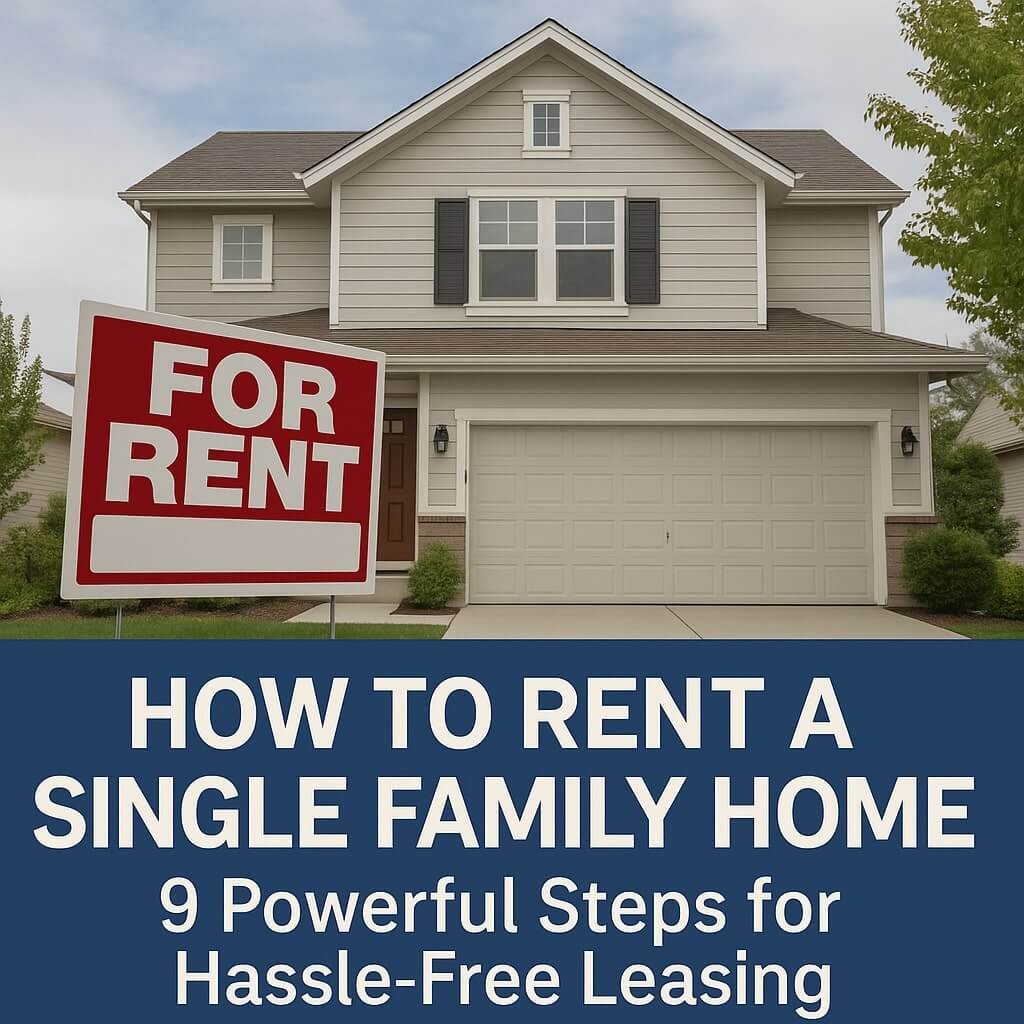A single-family home is a standalone residential structure designed to house one family. Unlike apartments or townhomes, these homes are not connected to other units and typically come with a private yard, garage, and more square footage. They’re ideal for renters seeking privacy, space, and a residential neighbourhood vibe.
Benefits of Renting a Single-Family Home
Renting a single-family home offers several advantages:
- More Space: You’ll generally get more square footage than in an apartment.
- Privacy: No shared walls or noisy upstairs neighbours.
- Outdoor Access: Yards, gardens, and garages add lifestyle value.
- Family-Friendly: Located in neighbourhoods with good schools and parks.
This housing option is great for families, remote workers, or anyone wanting a quieter living experience.
Step 1: Assess Your Budget and Needs
How Much Can You Afford?
Start by calculating your monthly income and subtracting your essential expenses. Financial experts recommend spending no more than 30% of your gross monthly income on housing.
| Monthly Income | Max Rent Budget (30%) |
|---|---|
| $3,000 | $900 |
| $4,500 | $1,350 |
| $6,000 | $1,800 |
Don’t forget to factor in utilities, internet, renter’s insurance, and possible HOA fees.
Must-Have vs. Nice-to-Have Features
List your non-negotiables and your preferences:
Must-Have:
- 3 bedrooms
- Fenced yard
- Within 30 minutes of work
Nice-to-Have:
- Walk-in closet
- Updated kitchen
- Hardwood floors
Knowing your priorities keeps your search focused and saves time.
Step 2: Start Your Rental Search Strategically
Best Platforms to Find Rentals
Use reputable platforms like:
- Zillow
- Realtor.com
- Craigslist (use with caution)
- Local property management websites
These sites let you filter results by location, price, and features.
Tips for Efficient Searching
- Set up alerts to catch listings early.
- Check daily, good properties go fast.
- Use maps to visualise commute and neighbourhood proximity.
- Bookmark promising listings and contact landlords promptly.
Being quick and prepared can give you an edge over other applicants.
Step 3: Evaluate Neighbourhoods Carefully
Safety, Schools, and Commute Considerations
Before committing, research:
- Crime rates through the police department or crime-mapping sites
- School ratings via district websites or GreatSchools
- Commute time and traffic patterns
Drive or walk around the neighbourhood to get a real feel for it.
Visit at Different Times of Day
What feels quiet at noon may be noisy at night. Visit in the morning, evening, and weekend to observe:
- Noise levels
- Traffic
- Lighting
- Activity
These insights help ensure you’re choosing a place that suits your lifestyle.
Step 4: Understand Rental Terms and Conditions
Key Lease Clauses to Watch For
Always read the lease in full. Pay close attention to:
- Rent amount and due date
- Late fees and grace periods
- Security deposit terms
- Pet policy
- Maintenance responsibilities
Month-to-Month vs. Long-Term Leases
- Month-to-month: Flexible but can be ended with short notice
- Long-term: More stability, but harder to leave early
Choose the lease type that best aligns with your life situation.
Step 5: Schedule Property Viewings
Questions to Ask the Landlord or Agent
When touring a property, don’t hesitate to ask pointed questions. Being informed can save you from future surprises. Consider asking:
- How long has the property been vacant?
- Who handles maintenance, and how quickly?
- Are utilities included in the rent?
- What’s the typical lease duration?
- Is renters’ insurance required?
These questions help you understand expectations, responsibilities, and potential deal breakers.
Red Flags During Property Tours
Be on the lookout for warning signs such as:
- Strong odours (mould, smoke, pets)
- Water damage or stains on ceilings/walls
- Unresponsive or vague landlords
- Poor security (broken locks, no outdoor lighting)
- Unmaintained yards or visible pests
Trust your instincts. If something feels off, it probably is.
Step 6: Prepare and Submit Your Rental Application
What Landlords Look For
Landlords want tenants who will pay on time and take care of the property. Typically, they’ll evaluate:
- Credit Score: A higher score indicates reliability.
- Rental History: Good references from previous landlords are a big plus.
- Income Verification: Usually, your monthly income should be 2.5–3x the rent.
- Background Check: Criminal records may affect eligibility.
How to Strengthen Your Application
Make your application stand out by:
- Providing recent pay stubs and bank statements
- Offering a larger security deposit
- Including a cover letter explaining why you’re a great tenant
- Having a co-signer, if needed
- Getting recommendation letters from past landlords
A well-prepared application boosts your chances in competitive markets.
Step 7: Review and Sign the Lease Agreement
Understanding Your Rights and Responsibilities
Before signing anything, read the lease word-for-word. Know your rights under state and local tenant laws, which typically cover:
- The right to a safe and habitable home
- Limits on security deposit amounts
- Procedures for handling repairs and notices
If unclear, consult a tenant advocacy group or legal advisor.
Getting Everything in Writing
Verbal agreements are risky. Always document:
- Repairs promised before move-in
- Any special arrangements (e.g., pet exceptions)
- Move-in and move-out dates
- Any additional charges
Signed documents protect both you and the landlord if issues arise.
Step 8: Plan Your Move-In Strategically
Setting Up Utilities and Services
Make arrangements for all necessary services:
- Electricity
- Gas
- Water and sewer
- Internet and cable
- Trash collection
Set activation dates to avoid delays or interruptions during your move.
Move-In Inspection Checklist
Inspect the property thoroughly and take photos. Note the condition of:
- Floors and carpets
- Walls and ceilings
- Appliances
- Windows and locks
- Plumbing fixtures
Record everything on a move-in checklist, and have the landlord sign it. This helps avoid disputes over your security deposit later.
Step 9: Build a Good Relationship with Your Landlord
Communicating Clearly and Respectfully
Good communication goes a long way. Be respectful, responsive, and professional when interacting with your landlord. Use email or written messages for important matters, and always keep records.
How to Handle Issues Promptly
If repairs are needed:
- Report them immediately.
- Follow up in writing.
- Document the issue with photos or videos.
- Know your rights if repairs are delayed or denied.
Handling concerns quickly helps maintain a positive rental experience for everyone involved.
FAQs About Renting a Single-Family Home
1. What’s the average credit score needed to rent a single-family home?
Most landlords prefer a credit score of 620 or above, though this can vary. Some may accept lower scores with an additional deposit or a co-signer.
2. Are utilities usually included in single-family home rentals?
Typically, tenants pay for all utilities, but this can differ by property. Always clarify what’s included before signing the lease.
3. Can I rent a single-family home with a pet?
Many landlords allow pets but may require a pet deposit or charge a monthly pet fee. Check the lease for pet policies and restrictions.
4. What’s the difference between renting a house and an apartment?
A single-family home offers more space, privacy, and outdoor access, while apartments may offer shared amenities and lower costs.
5. How long does the rental application process take?
Usually 2 to 5 business days, depending on how quickly references and background checks are completed.
6. What happens if I break the lease early?
You may be required to pay an early termination fee or forfeit your deposit. Always check your lease terms before making any moves.
Conclusion and Final Thoughts
Renting a single-family home can be a rewarding experience, offering privacy, space, and a sense of stability. By following the nine steps outlined in this guide, you’ll not only streamline the process but also set yourself up for a successful and stress-free leasing experience.
Take your time, do your homework, and don’t rush into any decisions. A well-informed renter is a confident renter, and that confidence makes all the difference in finding a home that fits your lifestyle and budget.













